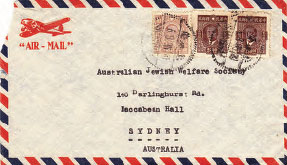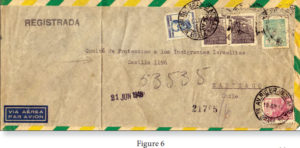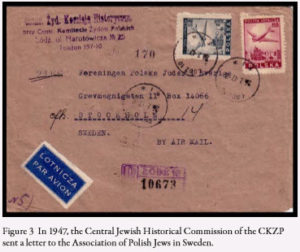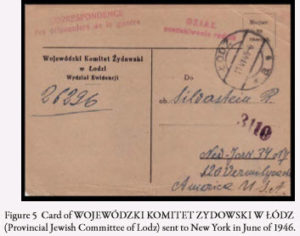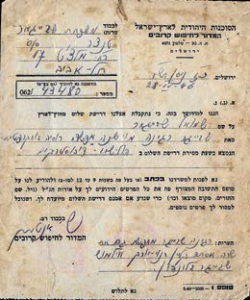HOLOCAUST
Thematic PHILATELIC
Presentation
Aftermath
-
DISPLACED PERSONS
-
ORGANIZATIONS PROVIDING HELP
-
GENERAL
Trials
Reparations
See below for more details where needed.
ORGANIZATIONS PROVIDING HELP
HIAS
(The Hebrew Immigrant Aid Society)
The covers shown was sent to the Australian Jewish Welfare Society from the Shanghai office of HIAS. It is tied to China, Scott 630, issued in December 1945 and Scott 572, issued in 1946, thereby indicating the earliest dates of these letters, both of which have indistinct postmarks.
HIAS – ITS ROLE IN THE YEARS SURROUNDING WORLD WAR II. The Israel Philatelist, October 2013 p 187.
HIAS
(The Hebrew Immigrant Aid Society)
There were many obstacles to Jewish immigration to Latin America after the war, including anti-Semitism and local economic problems. HIAS fought hard to overcome the multiple obstacles, with positive results6.
Evidence of the communication between Jewish advocacy groups is shown in the cover shown which depict a registered letter postmarked June 19, 1948 sent to the Comité de Protection a los Immigrantes Israelites (The Committee for the Protection of Jewish Immigrants) in Santiago, Chile from HIAS in Rio de Janeiro, Brazil.
The history of the Comité and its relationship to HIAS is instructive about the way HIAS connected to other Jewish refugee organizations.
HIAS – ITS ROLE IN THE YEARS SURROUNDING WORLDWAR II. The Israel Philatelist, October 2013 p 188.
Postwar Jewish Organizations
In Poland
Another branch of the Central Committee of Polish Jews was based in Łódz and used a rubber stamp with purple ink to apply its return address to correspondence. It name was the CENTR. ZYD. COMISJA HYSTORYCZNA, or Central Jewish Historical Commission
The committee sent a letter in 1947 to the Society of Polish Jews in Sweden. Many Polish Jews were able to escape to Sweden and spent the war there. Being the closest strictly neutral country to Poland, it was a haven for organizations and operations.
The Association of Polish Jews in Sweden must have been a very active organization as I have a second cover addressed to them from an unidentified sender.
Postwar Jewish Organizations In Poland. The Israel Philatelist, February 2009, p.12.
Postwar Jewish Organizations
In Poland
The evidence committee, Wydzial Ewidencji, of the WOJEWÓDZKI KOMITET ZYDOWSKI W ŁÓDZ (Provincial Jewish Committee of Lodz) sent a card to New York in June of 1946. This is the only communication on printed stationery that I have seen from a local committee.
When the ghetto was formed in 1940 it had over 160,000 inhabitants and when the war ended there were 900 survivors. Despite these small initial numbers, it became the largest post-war Jewish center as somewhere between 10,000 and 20,000 Jews who had survived the Nazi camps, or in Russia, returned to Łódz.
In the fall of 1945, the city had 20,000 registered Jews and 40,000 temporary residents. (The total number of Polish Jews surviving World War II and living temporarily in postwar Poland is believed to have been between 180,000 and 240,000). Figure 6 shows the ID of one of the 900 survivors of the ghetto who was able to emigrate and become an Israeli citizen.
Postwar Jewish Organizations In Poland. The Israel Philatelist, February 2009, p.12.
Lost Relatives Division
of the
Jewish Agency to Eretz Israel
Search for Lost Relatives Division of the Jewish Agency to Eretz Israel. The Israel Philatelist, Fall 2017, pp. 6-7.
RELATIVE SEARCH FORMS
In this truly needle-in-a haystack undertaking, the Jewish Agency for Eretz Israel would respond to well over a million requests for whatever shreds of information might offer a ray of hope-or, if not, then at least closure to their painful search. Join us as we raise the curtain on the Jewish Agency’s Search for Lost Relatives Division.
Figure 1 is a printed quasi-government form from the Jewish Agency to Eretz Israel, Search for Lost Relatives Division, dated April 28, 1946, in Jerusalem. The communication is to “The Shvaiger Family, c/o Tenzer, 17 Melchet St.” This folded form was posted with a 3-mils machine duplex cancel with Jerusalem circular dated cancellation (CDC) dated April 30, 1945 (Figure 2). We paraphrase the communication as follows with parenthetic explanatory notations:
Dear Sir/Madame:
We hereby inform you that we have received a greeting (message) from abroad bearing the name: Shmuel Shvaiger (conversion of names into Hebrew were frequently done phonetically so that the actual spelling may be different), from Regina Shvaiger from Vishna, possibly Carpathian Russia, who resides now in Holishiv, Czechoslovakia.
Please respond to our office in writing or by voice and let us know by the enclosed reply form (not part of our acquisition and therefore likely forwarded back accordingly) all the details known to you on the person above (age, parents’ names, place of origin, etc.) so that if this message is meant for you we shall then be able to provide you with additional details.
Regina Shvaiger is also in search of Sara Esther Klein in New York, and Vilmush Shvaiger in London.”
Sincerely yours, S. Antman,
Search for Lost Relatives Division
Figures 1 – 2
Jewish Agency to Eretz Israel, Search for Lost Relatives Division enquiry response form and form machine cancellation
Figure 1
Figure 2
DISPLACED PERSONS
- At the end of World War II there at least 11 million people who were displaced from their home countries. These included Jewish survivors of concentration camps.
- The refugees were categorized by the Allies as “displaced persons (DPs).
- System for resolving displacement.
- The original plan for those displaced as a result of World War II was to repatriate them to their countries of origin as quickly as possible.
- On October 1, 1945, the United Nations Relief and Rehabilitation Administration (UNRRA) took responsibility for the administration of displaced persons in Europe, though military authorities continued to play a role for several years to come, in providing transportation, supplies and security.
- Camps.
- Displaced persons began to appear in substantial numbers in the spring of 1945. Allied forces took them into their care by improvising shelter wherever it could be found.
- By 1952, all but two DP camps were closed. The last two DP camps, Föhrenwald closed in 1957 and Wels in 1959.
- Needs of displaced persons.
- All displaced persons had experienced trauma, and many had serious health conditions as a result of what they had endured.
- The immediate concern was to provide shelter, nutrition and basic health care.
- A number of charitable organizations provided significant humanitarian relief and services among displaced persons – these include the American Jewish Joint Distribution Committee,
- Difficulties of repatriation.
- “Over one million refugees could not be repatriated to their original countries and were left homeless as a result of fear of persecution. These included:
- Ethnic or religious groups that were likely to be persecuted in their countries of origin. These included a large number of Jews (see Sh’erit ha-Pletah), and others.”
- “Jewish survivors of the death camps and various work camps refused to return to their countries of origin, starting instead an extensive underground movement to migrate to the British Mandate of Palestine. Jewish Holocaust survivors typically could not return to their former homes because these no longer existed or had been expropriated by former neighbors; the few Eastern European Jews who returned often experienced renewed antisemitism. In 1945, most Jewish Holocaust survivors had little choice but to stay in the DP camps; most Jews who wanted to could not leave Europe because Britain had severely limited legal Jewish immigration to Palestine and illegal immigration was strongly curtailed. Jewish refugees hoping to reach other countries, including the United States, also met with restrictions and quotas.”
- “Over one million refugees could not be repatriated to their original countries and were left homeless as a result of fear of persecution. These included:
- Resettlement of DPs.
- “Once it became obvious that repatriation plans left a large number of DPs who needed new homes, it took time for countries to commit to accepting refugees. Existing refugee quotas were completely inadequate, and by the fall of 1946, it was not clear whether the remaining DPs would ever find a home.”
- Of the DPs the US admitted from eastern Europe between 1941 and 1957, 137,450 were European Jews.
Retrieved from https://en.wikipedia.org/w/index.php?title=Displaced_persons_camps_in_postWorld_War_II_Europe&oldid=860366398”
GENERAL
- Trials
- “The Nuremberg trials were a series of military tribunals, held by the Allied forces after World War II in Nuremberg, Germany, to prosecute prominent members of the political, military, and economic leadership of Nazi Germany.”
- “Other trials of Nazis and collaborators took place in Western and Eastern Europe414-428}} In 1960, Israeli Mossad agents kidnapped Adolf Eichmann in Argentina and brought him to Israel to stand trial for war crimes. The trial ended in his conviction in December 1961, and his execution in May 1962. Eichmann’s trial and death revived interest in war criminals and the Holocaust in general.”
- Reparations
- “In March 1951, the government of Israel requested $1.5 billion from the Federal Republic of Germany to finance the rehabilitation of 500,000 Jewish survivors,”
- “The Conference on Jewish Material Claims Against Germany (known as the Claims Conference) was opened in New York, and after negotiations, the claim was reduced to $845 million.”
- “In 1988, West Germany allocated another $125 million for reparations.”
- “The French state-owned railway company, the SNCF, agreed in 2014 to pay $60 million to Jewish-American survivors, around $100,000 each, for its role in the transport of 76,000 Jews from France to extermination camps between 1942 and 1944.”
Retrieved from https://en.wikipedia.org/w/index.php?title=The_Holocaust&oldid=867975094

